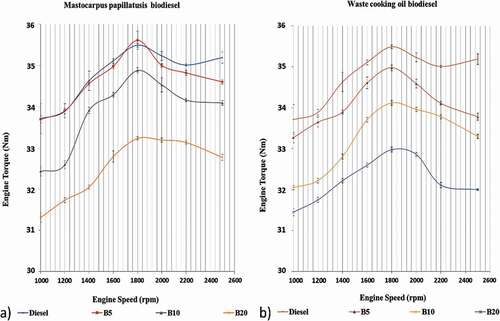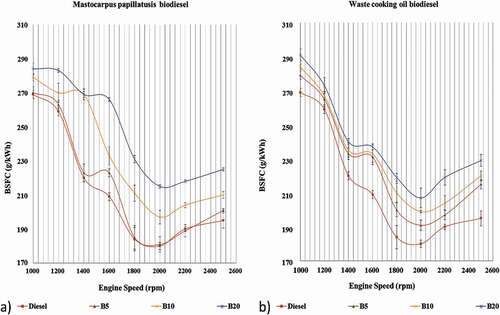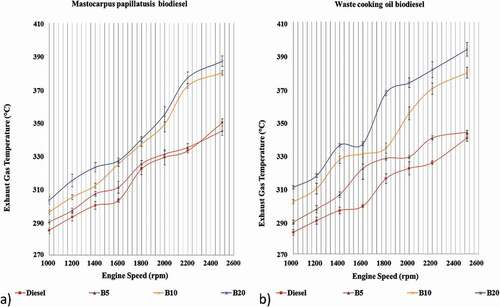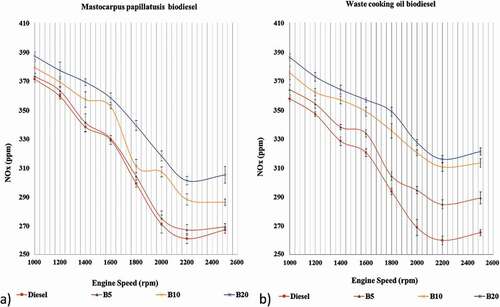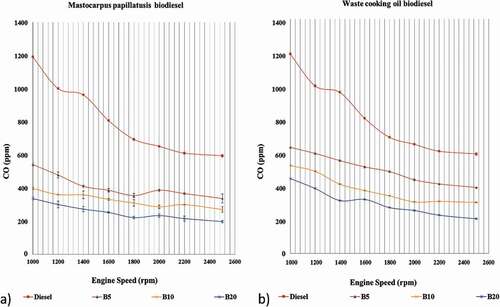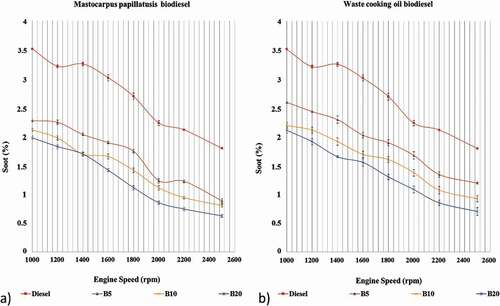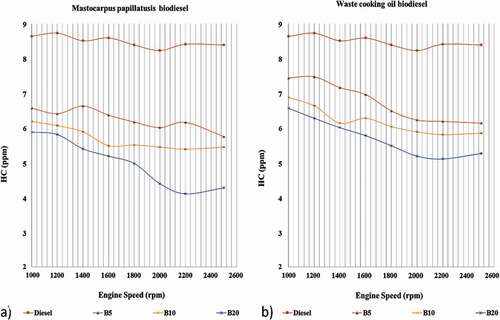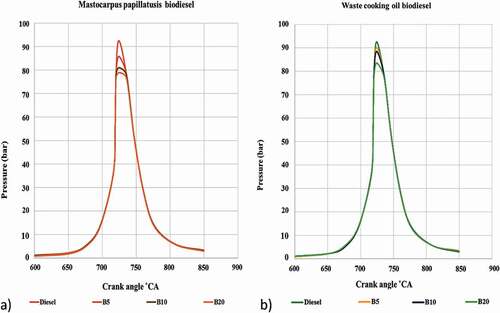ABSTRACT
The present paper aims to show the difference between fresh feed oil and waste cooking oil and their effect on Engine performance, Exhaust gases, and Combustion Engine. This study has used waste cooking oil (sheep tallow) (WCO) as well as a new species of algae (Mastocarpus papillatus). The results indicate that the torque, power, brake specific consumption, Exhaust gas temperature, and NOx emission of fresh feed give much closer results to diesel fuel, and their difference for 5% biofuel with WCO is around 2–3%, 2–6%, 6–7%, 1–3%, and 2–9%. The CO, soot, and HC emission of fresh feed nave much better results to diesel fuel, and their difference for 20% biofuel with WCO is around 5–25%, 6–12%, and 11–19%. Compared to waste oil, the peak pressure for fresh feed was lower; therefore, being compared to waste fuel, the fresh feed shows better results for emission and performance in the engine.
1. Introduction
The growth of population and the increasing need for fossil fuels has turned into one of the biggest problems in human societies. Fossil fuels own many disadvantages and problems, out of which the environmental impacts and the scarcity or absence of their resources might be named as the biggest disadvantages (Singh et al. Citation2020); Only the two mentioned factors cause the fuels hazardous to the ozone layer; besides, their price is faced with a constant increase. One of the highly considered fuels in the contemporary era and can solve many problems is biofuel. This type of fuel has many advantages, out of which its low production of sulphur as well as its biodegradability can be indicated (Ardjmand, Jafarihaghighi, and Mirzajanzadeh Citation2020).
Edible vegetable oils are usually considered the first generation. Currently, most biodiesel production is generated via this generation; however, this generation has many disadvantages. While most countries in the world have difficulty producing their food, this generation engenders many arable lands to be cultivated. This might directly impact the cost of products and create a competitive atmosphere that increases the price of food products. Therefore, non-edible vegetable oils are considered the second generation. Although this generation does not affect food, it can produce an industrial scale and very little variety that creates a monopoly globally, which would increase prices. Nowadays, Algae and waste cooking oil have attracted a lot of attention and are considered the third generation of biodiesel. The most important advantage of this generation is that it can be cultivated in bad weather conditions; besides, it doesn’t necessarily need agricultural land. Also, this generation has enough variety of production (Ardjmand, Jafarihaghighi, and Mirzajanzadeh Citation2020).
Many reports being made on the first, second, and third generations have demonstrated their cultivation ability. The most recent reports are the following examples. Bueno et al. used the first generation of biodiesels, and there were castor and soybean oil. They could reach that both elements were enhancing the amount of NOx, though; the amount of NOx was lower for castor oil. They also referred that the PM for soybean was lower than castor during low engine load (Bueno et al. Citation2017). Farid et al. applied Zingiber officinale, Anethum graveolens, and cacao bean in the engine. They showed that the amount of NOx, HC, and CO were higher than other generations (Jafarihaghighi et al. Citation2021); moreover, they have worked on the second generation of biodiesel; They also used Common wormwood, Marjoram, and Peganum harmala in their study. Their results showed that NOx, HC, and CO emissions were lower than the first generation and higher than the third generation of biodiesel (Jafarihaghighi et al. Citation2021). Finally, Devarajan et al. applied cashew nut in their study. They depicted that cashew nutshell reduced HC CO, Smoke, and NOx emissions by around 2.6%, 10.1%, 2.1%, and 5.1%, respectively (Devarajan et al. Citation2017). Subramaniam et al., in their study, applied the algae as fuel. They showed that 20% of biodiesel could show better results and decrease HC, CO, particulate matter, and smoke emissions. On the other hand, compared to different samples, the amount of NOx and CO2 was enhanced. Concerning heat release rate and cylinder pressure, the peak rate, compared to diesel, gained lower smoke at higher load circumstances (Subramaniam et al. Citation2020). Giridharan et al. used the algae blooms in their study. The Results indicated that the blended biodiesel, compared to diesel, reduced environmental pollution and prepared superior efficiency (Giridharan, Vennimalai Rajan, and Radha Krishnan Citation2020). Nirmala et al. employed Chlorella variables in their study and showed that Inferior CO, HC, and upper CO2 emissions were found in algae biodiesel. They showed that growing algae blends decreased the smoke opacity (Nirmala, Dawn, and Harindra Citation2020). Hariram et al. proved that neat algal biodiesel, being exposed to raise in-cylinder pressure, caused the rate of pressure growth and heat release. Compared to cottonseed biodiesel, algal biodiesel showed upper brake thermal efficiency (Hariram et al. Citation2019). Nautiyal et al. showed that the amount of heat release, compared to cottonseed biodiesel, for algae biodiesel was inferior. With the increase of biodiesel blends, CO, smoke, and HC emissions were declined. NOx emission increased during the rise of biodiesel blends (Nautiyal et al. Citation2020). Alga biodiesel was used in the work of Abed et al. They showed that, compared to other samples, 10 and 20% biodiesel could show better results; Therefore, the amount of CO, HC, smoke, and CO2 emissions are lesser for biodiesel blends. On the other hand, the maximum NOx emission was shown by that 10 and 20% biodiesel compared to other fuels (Abed et al. Citation2019). Pugazhendhi et al. employed Scenedesmus obliquus and Scenedesmus dimorphus in their study. They displayed that there was a minor growth in BSFC with low BP. All emissions in this study could decrease by using biodiesel except for NOx emission (Pugazhendhi et al. Citation2020). Yesilyurt et al. in their studies applied waste cooking oil as biodiesel. Outcomes proved that the amount of smoke opacity, BP, torque, and CO diminished by using biodiesel; However, the rate of BSFC, exhaust gas temperature, CO2, and NOx enhanced. They also mentioned that the improvement of injection pressure triggered to grow in the torques, BP, and BTE around 210 bar. Additionally, in spite of the promotion of CO2 and NOx emissions, the enhancement of injection pressure made to decline in smoke opacity and HC (Yesilyurt Citation2019). Bencheikh et al., in their study, applied waste cooking oil in the presence of propanol as biofuel. They demonstrated that engine performance and emissions exposed that propanol addition improved BSFC and declined CO, EGT, smoke, and NOx. This study also verified the ternary blends feasibility in cold flow (Bencheikh et al. Citation2019).
In this report, we have used new third generation of biodiesel (algae) that can grow in most parts of the world. Waste oil is used either. The main goal is to show the difference between pure oil and waste in the report, which shows its effect on engine performance, exhaust emissions, and combustion which is not considered in previous studies; besides, one of the purposes of this article is to show which feed (waste or fresh) have better environmental impacts and better engine performance for providing a better perspective for future studies.
2. Materials and methods
2.1. Materials
Two different oils, comprising Mastocarpus papillatus and (sheep tallow) waste cooking oil, have been examined here. Mastocarpus papillatusis is a kind of red algae in the family of Rhodophyta. This plant has very good compatibility to grow in areas that have access to water, and this plant usually grows between rocks; therefore, it is a good option for many countries and also it does not have the human food chain like the first generation or limited samples like the second generation.
Both samples have been catered by Soda-ye Shirin Rayan company. Mastocarpus papillatus finds in moist, dark patches of trees, soil and rocks. Then, they cleaned for removing other materials. Mastocarpus papillatus dried for 3–4 days, and after that they were pulverised. Then, due to extracting lipids, they crushed several times in the presence of isopropanol and hexane solvent mixture. The lipid was separated from the biomass. So, it was heated so that the solvent in it was removed. A pretreatment procedure was performed with the methanol-to-oil (0.3 (v/v)) in the presence of 1% H2SO4 (v/v) (acid catalyst) for 1 h at 58°C., subsequently, the mixture was settled in 1.5 h; Therefore, the methanol-water fraction was separated at the top. So, the bottom phase acid value was specified; besides, methanol (99%) and KOH (99%) were obtained and equipped by Aldrich Chemical Co. (USA). The properties of crude oils and the uncertainty calculation are indicated in .
Table 1. The characterises of crude oils
Table 2. The uncertainty calculation characterises
2.2. Preparation of fuels
The transesterification procedure was applied for biodiesel construction. First, the KOH-catalysed was applied for a reaction; this method was done with 1 to 3 (v/v) methanol-to-oil ratio. Roughly 2.2 g KOH was distributed and dissolved in 130 ml of methanol. This blend of methoxide and oil was heated for about 1 hour at 55–60°C. The material retrieve was catered for washing (warm distilled water). This method was performed many times to eliminate contaminants, and it was separated by centrifuge. Finally, the amount of acid was checked.
The amount of density and viscosities were shown with Anton Paar, SVM3000 model (Anton Paar Co., Austria), and Stabinger Viscometer. The rate of density was controlled by the ASTM standard (D4052). The rate of viscosity was specified by the ASTM standard (D445); Furthermore, Gas Chromatography (Claus 580 GC model, Perkin Elmer Co, USA) was used for all samples. The experiment was done by 0.1 g of the acquired biodiesels, and it was added to the dilute solution (about 1 ml.). The blend was transported to an injection vial. The nonadecanoate was applied as an internal standard. So, the solution employed in this test was heptane. The standard applied in the appliance was EN 14,103. Concerning the concentration of mixtures, the detector responded. Chromatograms gained from the detector could be observed and done. The Octan-IM device exhibited CN. The procedure was that each biodiesel was placed separately in different containers, and then the tubular part of the device was inserted into the biodiesel, and that was kept in a fixed state inside the biodiesel for a few moments. After 1 minute, when the CN was reached a constant value, we recorded its value. ASTM standard D93 evaluated the flashpoint with a constantly close cup flash point (CCCFP) tester applying the Grabner FLPH Miniflash Tester (Grabner, Austria). All apparatus are presented in .
Table 3. The properties of apparatus
2.3. Engine features
An Italian Lombardy Company 3LD 510 model was applied. Its circumstances are shown in . The dynamometer model was Eddy Current WE400 (Pars Andish Innovative Company). The dynamometer was joined to the motor via the guard shaft. By applying a magnetic ground, the current dynamometer computed the torque value. It measured the rotational speed though the magnetic sensor. To obtain the procedure status of engine parts, many sensors containing temperature sensors, engine outlet water temperature, EGT, air manifold pressure, and engine fuel flow were mounted. The MAHA-MGT5 was employed for calculating HC, CO, and CO2; Furthermore, the tests were taken 3 times (). The numbers completed via this system were revealed through the EURO System (MAHA) software. In defining pollutants, the crucial point was the engine temperature. Sensors were positioned in the engine oil chamber, and the oil temperature could be between 60°C and 100°C. The boundary state was shown in . The engine parameters performance is stated as the maximum torque. The net biofuels are also added to diesel fuel in various mixtures (B5, B10, and B20). The fuel features are shown in .
Table 4. Diesel engine characterises implemented in the examination
Table 5. MAHA-MGT5 analyser specifications implemented in the examination
Table 6. Determined initial and boundary situations
Table 7. Properties of the Mastocarpus papillatusis biodiesel in varied blends
Table 8. Properties of the waste cooking oil biodiesel in varied blends
2.4 Fatty acids profile
The fatty acids are demonstrated in . The supreme amount of saturated acids is shown in the Mastocarpus papillatusis biofuel. The higher unsaturated acids were obtained by waste cooking oil biofuel. The longest chain length was presented by Mastocarpus papillatusis biofuel. According to , the maximum quantity of hydrogen to carbon (H/C) and oxygen to carbon (O/C) was gained by Mastocarpus papillatusis.
Table 9. Fatty acid in net biodiesel examples
3. Results and discussion
3.1. Engine torque
Torque differences for the samples are revealed in . The error bar was between ±0.1 and ±0.01 Nm. Conferring to all biodiesels in all samples, with growing engine speed the amount of torque also increased. The torque amount declined gradually for all biodiesels at 1800 rpm. The reduction of Mastocarpus papillatusis biodiesel was closely 3%, 3%, and 2% for B5, B10, and B20, respectively. The lessening of waste cooking oil biodiesel was approximately 4%, 3%, and 3% for B5, B10, and B20, respectively. Compared to waste cooking oil biodiesel, the topmost torque was exposed by the Mastocarpus papillatusis biodiesel at 1000 rpm. It was around 33.69, 32.43, and 31.31 Nm for B5, B10, and B20, respectively. At this rpm for waste cooking oil, it was around 33.06, 31.98, and 31.45 Nm for B5, B10, and B20, respectively. The amount of Mastocarpus papillatusis biodiesel, at 1200 rpm was higher than waste cooking oil biodiesel and it was around 33.70, 32.45, and 31.76 Nm for B5, B10, and B20, respectively. At this rpm for waste cooking oil biodiesel, it was around 33.53, 32.22, and 31.75 Nm for B5, B10, and B20, respectively. This process was the same for both biodiesels; besides, Mastocarpus papillatusis biodiesel was higher than waste cooking oil biodiesel at 1400, 1600, 1800, 2000, 2200, and 2500 rpm. In addition, compared to waste cooking oil biodiesel the principal torque was exposed by the Mastocarpus papillatusis biodiesel at 2500 rpm (Ong et al. Citation2014b). From the perspective of viscosity, the level of viscosity develops with the carbon chain length. Consequently, Mastocarpus papillatusis, compared to the waste cooking oil biodiesel, had not a long amount of carbon chain and it presented inferior viscosity outcomes (Damanik et al. Citation2018). Additionally, HHV enlarged with the carbon chain (the alteration between samples was low) and saturated fatty acid; Mastocarpus papillatusis biodiesel had high saturated acids and chain length (Knothe and Steidley Citation2005); Consequently, over the development of the biodiesel blending, the amount of torque diminished. The chief reason for the reduction is associated with the HHV and viscosity (Ong et al. Citation2014a, Citation2014b). The enhancement of the viscosity and diminishment of HHV cause the decline of torque (Buyukkaya Citation2010).
3.2. Brake specific fuel consumption (BSFC)
The BSFC was demonstrated in for both samples. The error bar was between ±14 and ±2 g/kWh. Conferring to the samples, they've had a decline with growing engine speed. The BSFC amount diminished frequently for all biodiesels. The lessening of Mastocarpus papillatusis biodiesel was virtually 26%, 25%, and 21% for B5, B10, and B20, respectively. The falling of waste cooking oil biodiesel was almost 23%, 23%, and 22% for B5, B10, and B20, respectively. Compared to Mastocarpus papillatusis biodiesels, the superior BSFC was indicated by the waste cooking oil biodiesel at 1000 rpm it was about 279, 283, and 295 g/kWh for B5, B10, and B20, respectively. At 1000 rpm for Mastocarpus papillatusis, BSFC was around 270, 279, and 288 g/kWh for B5, B10, and B20, respectively. At 1200 rpm, the amount of Mastocarpus papillatusis biodiesel was lower than waste cooking oil biodiesel and it was around 263, 270, and 283 g/kWh for B5, B10, and B20, respectively. At this rpm for waste cooking oil, it was round 265, 271, and 273 g/kWh for B5, B10, and B20, respectively. This process was the same for both biodiesels, and Mastocarpus papillatusis biodiesel was lower than the waste cooking oil biodiesel at 1400, 1600, 1800, 2000, 2200, and 2500 rpm; Moreover, at 2500 rpm, compared to waste cooking oil biodiesels, the lowermost BSFC was presented by the Mastocarpus papillatusis biodiesel. BSFC was near 201, 210, and 225 g/kWh for B5, B10, B20, respectively. All biodiesels witnessed a decrease till 2000 rpm and after that they all improved a bit. The fatty acids affect the viscosity and HHV, and both can impact BSFC (Prabhu, Venkata Ramanan, and Jayaprabakar Citation2020). The viscosity enhances the carbon chain;Therefore, compared to the waste cooking oil, Mastocarpus papillatusis biodiesel had the bottommost amount of carbon chain and revealed slighter BSFC results. In addition, HHV provokes with the chain length and saturated acid, and Mastocarpus papillatusis biodiesel had long chain length and saturated acids (Knothe and Steidley Citation2005). So, the BSFC value developed during the expansion of biodiesel blending. The chief reason for the development is related to HHV and viscosity. The enhancement of the viscosity and diminishment of HHV makes the growth of BSFC (Buyukkaya Citation2010). Compared to the waste cooking oil biodiesel, The Mastocarpus papillatusis biodiesel displayed the lower BSFC. It was connected to the O/C and properties, and triggered the hastened reactions, which contributed to better combustion. Therefore, the supreme BSFC illustrated by biodiesel produced from waste oil, and biodiesel produced from fresh oil showed better results than biodiesel produced from waste oil.
3.3. Exhaust gas temperature
The EGT is displayed in for both fuels. The error bar was between ±11 and ±2°C. Compared to other fuels at all engine speeds, the rate of EGT was inferior for diesel fuel. The expansion in the EGT observed the development of biodiesel content. The promotion of Mastocarpus papillatusis biodiesel was about 16%, 23%, and 21% for B5, B10, and B20, respectively. The promotion of waste cooking oil biodiesel was about 18%, 23%, and 24% for B5, B10, and B20, respectively. The bottommost EGT, compared with waste cooking oil biodiesel, was showed by the Mastocarpus papillatusis biodiesel at 1000 rpm; therefore, it was around 290°C, 296°C, and 303°C for B5, B10, and B20, respectively. At this rpm for waste cooking oil biodiesel, it was around 292°C, 306°C, and 316°C for B5, B10, and B20, respectively. At 1200 rpm, the amount of Mastocarpus papillatusis biodiesel, being lower than waste cooking oil biodiesel, was around 297°C, 305°C, and 315°C for B5, B10, and B20, respectively. At this rpm for waste cooking oil biodiesel, it was around 301°C, 315°C, and 324°C for B5, B10, and B20, respectively. This process was the same for both biodiesels; besides, Mastocarpus papillatusis biodiesel was lower than waste cooking oil biodiesel at 1400, 1600, 1800, 2000, 2200, and 2500 rpm. Compared to waste cooking oil biodiesels, the bottommost EGT was exhibited by the Mastocarpus papillatusis biodiesel at 2500 rpm. So, it was near 345°C, 380°C, 383°C, and 387°C for B5, B10, and B20, respectively. The growth of unsaturation acids and the reduction of the carbon chain might diminish the CN (Aydin and Bayindir Citation2010). Mastocarpus papillatusis biodiesel, compared to waste cooking oil biodiesels, had a long carbon chain and a high level of saturation acids, and also it could enhance CN. Thus, EGT was influenced by the distinctions in ignition delay. Thus, prolonged ignition delay yields to a basic EGT and delayed combustion. As well, the slighter CN reasons, an extended ignition delay. So, the supreme EGT, illustrated by biodiesel, produced from waste oil, and biodiesel made from fresh oil showed better results than biodiesel produced from waste oil.
3.4. NOx emission
The NOx is indicated in for the Mastocarpus papillatusis and waste cooking oil biodiesel. The error bar was between ±15 and ±4 ppm. The decrease in the NOx illustrated over the enlargement of the biodiesel content. The lessening of Mastocarpus papillatusis biodiesel was nearly 28%, 25%, and 22% for B5, B10, and B20, respectively. The falling of waste cooking oil biodiesel was around 23%, 18%, and 19% for B5, B10, and B20, respectively, compared to waste cooking oil biodiesel, the lowermost NOx was revealed by the Mastocarpus papillatusis biodiesel at 1000 rpm; It was around 373, 379, and 387 ppm for B5, B10, and B20, respectively. For waste cooking oil biodiesel, it was around 378, 391, and 403 ppm for B5, B10, and B20, respectively, at this rpm. The amount of Mastocarpus papillatusis biodiesel was lower than waste cooking oil biodiesel at 1200 rpm, and it was around 363, 369, and 377 ppm for B5, B10, and B20, respectively. At this rpm for waste cooking oil biodiesel, it was around 367, 376, and 388 ppm for B5, B10, and B20, respectively. This process was the same for biodiesels, and Mastocarpus papillatusis biodiesel was lower than waste cooking oil biodiesel at 1400, 1600, 1800, 2000, 2200, and 2500 rpm. In addition, at 2500 rpm, the lowermost NOx was verified by the Mastocarpus papillatusis biodiesel compared to waste cooking oil biodiesel. It was nearby 269, 286, and 305 ppm for B5, B10, B20, respectively. The property of ignition is typically affected via CN. High CN amount indicated short ignition delay, displayed inferior fuel energy in the premixed phase, and so, slighter NOx emissions through the premixed period; consequently, the waste cooking oil biodiesel had upper NOx emission with the lowest CN. The lowest NOx emission was associated with Mastocarpus papillatusis biodiesel and comprised the top value of CN (Islam, Rashid, and Arefin Citation2021). The creation of NOx is connected to combustion duration, volumetric efficiency, and the temperature rising from excessive activation energy desired for the reactions involved. The EGT had a dissimilar effect on NOx emission, as the expansion in volumetric efficiency plus gas flow motion and the engine cylinder; therefore, this procedure contributed to earlier mixing among fuel, air, and smaller ignition delay (Buyukkaya Citation2010; Devarajan et al. Citation2018; Jafarihaghighi et al. Citation2020a). The long carbon chains raise the quantity of CN and drop the rate of NOx. Thus, Mastocarpus papillatusis biodiesel had a long carbon chain and great CN, which influence NOx and diminish that (Mwangi et al. Citation2015); Furthermore, mounting the value of saturated acids and deteriorating the number of double bonds, rise the number of CN and lessen the amount of NOx. Also Mastocarpus papillatusis biodiesel had the highest saturated acids and minimum double bonds (Pinzi et al. Citation2013). So, the supreme NOx illustrated by biodiesel produced from waste oil, and biodiesel produced from fresh oil, showed better results than biodiesel produced from waste oil.
3.5. CO emissions
CO emission is displayed in for the Mastocarpus papillatusis and waste cooking oil biodiesel blends and diesel. The error bar was between ±40 and ±4 ppm. The measure of the CO declined with the mounting engine speed. The lessening of Mastocarpus papillatusis biodiesel was around 38%, 32%, and 42% for B5, B10, and B20, respectively. The B20 presented a high reduction for all biodiesels. The falling of waste cooking oil biodiesel was around 38%, 42%, and 54% for B5, B10, and B20, respectively. The lowest CO was presented by the Mastocarpus papillatusis biodiesel. At 1000 rpm, the rate of CO for Mastocarpus papillatusis biodiesel was roughly 542, 398, and 337 ppm for B5, B10, and B20, respectively. At this rpm, it was around 634, 525, and 447 ppm for B5, B10, and B20, respectively for for waste cooking oil biodiesel. At 1200 rpm, the amount of Mastocarpus papillatusis biodiesel, being lower than waste cooking oil biodiesel, was around 479, 361, and 301 ppm for B5, B10, and B20, respectively. At this rpm, it was round 598, 491, and 388 ppm for B5, B10, and B20, respectively, for waste cooking oil biodiesel. This process was the same for both biodiesels; and at 1400, 1600, 1800, 2000, 2200, and 2500 rpm, Mastocarpus papillatusis biodiesel was lower than waste cooking oil. Besides, compared to waste cooking oil biodiesel, the lowermost CO was presented by the Mastocarpus papillatusis biodiesel at 2500 rpm. It was close to 337, 271, 198 ppm for B5, B10, and B20, respectively. The drop of CO emission can arise as the oxygen that yields to easier burning at superior temperatures in the cylinder. Thus, this is proved by the smaller carbon chain’s superior oxygen content that has led to the complete and cleaner combustion. Additionally, there are methyl esters with lengthy carbon chains that have upper melting and boiling points; therefore, it is less probable for them to be completely vaporised and burnt, consequently the CO emission is enhanced. Mastocarpus papillatusis biodiesel and waste cooking oil biodiesel had virtually the same carbon chain; however, the amount of O/C for Mastocarpus papillatusis biodiesel, owing to the lower CO emission, was higher (Hellier et al. Citation2018). So, the supreme CO emission, illustrated by biodiesel produced from waste oil, and biodiesel produced from fresh oil, showed better results than biodiesel produced from waste oil. At the lowermost engine speed, fuel atomisation problems resulted from the air-fuel mixing procedure as the upper viscosity; this object stated that the engine desired more air over the combustion procedure (Aydin and Bayindir Citation2010).
3.6. Soot emission
The soot emission is indicated in for the Mastocarpus papillatusis and waste cooking oil biodiesel. The error bar was between ±0.1 and ±0.02 Vol%. The lessening in the soot is witnessed over the extension of the biodiesel sample content. The lessening of Mastocarpus papillatusis biodiesel was nearly 62%, 63%, and 69% for B5, B10, B20, respectively. The fall of waste cooking oil biodiesel was adjacent to 55%, 58%, and 67% for B5, B10, B20, respectively. compared to waste cooking oil biodiesels,The least soot emission was exhibited by the Mastocarpus papillatusis biodiesel at 1000 rpm. It was around 2.27, 2.11, and 1.97 Vol% for B5, B10, and B20, respectively. At this rpm for waste cooking oil biodiesel, it was round 2.59, 2.19, and 2.11 Vol% for B5, B10, and B20, respectively. At 1200 rpm, the amount of Mastocarpus papillatusis biodiesel was lower than waste cooking oil biodiesel and it was around 2.24, 1.97, and 1.82 Vol% for B5, B10, and B20, respectively. At this rpm for waste cooking oil biodiesel, it was round 2.43, 2.12, and 1.91 Vol% for B5, B10, and B20, respectively. This process was the same for both biodiesels and Mastocarpus papillatusis biodiesel was lower than waste cooking oil biodiesel at 1400, 1600, 1800, 2000, 2200, and 2500 rpm. In addition, compared to waste cooking oil biodiesels, the bottommost soot emission, at 2500 rpm, was confirmed by the Mastocarpus papillatusis biodiesel. It was near 0.88, 0.80, 0.62 Vol% for B5, B10, and B20, respectively. The soot exam presented that the progress of the carbon chain could affect soot. Noticeably, the progress of the carbon chain developed soot. While the variance of carbon chain was not noteworthy, compared to waste cooking oil biodiesel, the shortest carbon chain was obtained by Mastocarpus papillatusis biodiesel; this disagreed with the prior study, which presented that the development of the carbon chain did not enhance soot [24]. This arose due to the oxygen content, and also it could lessen with the development of chain length. The high oxygen content of fuels diminished soot precursor formation. The results revealed that the great oxygen content was associated with Mastocarpus papillatusis biodiesel. It was noticeable that a drop in oxygen content had a reverse inference on the soot; furthermore, waste cooking oil biodiesel had the lowermost O/C ratio and enhanced the soot. The better O/C ratio weakened soot (Pinzi et al. Citation2013; Zhu, Cheung, and Huang Citation2016). The topmost rate of unsaturated acids and double bonds observed in waste cooking oil biodiesel were in contrast to Mastocarpus papillatusis biodiesel. As the unsaturated acids and double bonds value-enhanced, the rate of soot enhanced either (Pinzi et al. Citation2013). The H/C ratio exhibited the saturated acids value. The expansion of this amount had an indirect result on soot; as the fuel burned well, triggered soot emission declined and Mastocarpus papillatusis biodiesel, compared to waste cooking oil biodiesel, had upper H/C. So, the supreme soot emission illustrated by biodiesel produced from waste oil and biodiesel produced from fresh oil showed better results than biodiesel produced from waste oil.
3.7. HC emission
The HC is indicated in for the Mastocarpus papillatusis and waste cooking oil biodiesel. The error bar was between ±0.03 and ±0.01 ppm. The Mastocarpus papillatusis biodiesel verified the lowest HC at 1000 rpm compared to waste cooking oil biodiesel. It was around 6.57, 6.19, and 5.88 ppm for B5, B10, and B20, respectively. The greater HC displayed by the waste cooking oil biodiesel was about 7.44, 6.88, and 6.57 ppm for B5, B10, and B20, respectively. At this rpm for Mastocarpus papillatusis biodiesel, it was around 6.57, 6.19, and 5.88 ppm for B5, B10, and B20, respectively. The amount of Mastocarpus papillatusis biodiesel at 1200 rpm was lower than waste cooking oil biodiesel and it was around 6.41, 6.07, and 5.81 ppm for B5, B10, and B20, respectively. Waste cooking oil biodiesel at this rpm was around 7.47, 6.64, and 6.28 ppm for B5, B10, and B20, respectively. This process was the same for both biodiesels and Mastocarpus papillatusis; biodiesel was lower than waste cooking oil biodiesel at 1400, 1600, 1800, 2000, 2200, and 2500 rpm. In addition, compared to the waste cooking oil, at 2500 rpm, the lowest HC was demonstrated by the Mastocarpus papillatusis biodiesel. It was near 5.75, 5.45, and 4.28 ppm for B5, B10, and B20, respectively. Nevertheless, compared to Mastocarpus papillatusis biodiesel, the maximum HC was exposed by the waste cooking oil biodiesel at 2500 rpm; it was almost 6.14, 5.85, and 5.27 ppm for B5, B10, and B20, respectively. The increase ingas temperature and the attendance of greater CN as in charge of this lessen could clarify for biodiesels as superior burned gas temperature forbidden the weightiest hydrocarbons condensation (Karmakar, Kundu, and Rajor Citation2018). Moreover, the superior CN of biodiesel motives a decrease in HC emissions because of the drop in combustion delay (Monyem, Van Gerpen, and Canakci Citation2001). Alternatively, the fatty acids value might affect the amount of CN. Thus, the rise of saturated acids and carbon chain can rise the CN; Mastocarpus papillatusis biodiesel had both long carbon chain and saturated acids and, compared to waste cooking oil biodiesel, it affected the drop of supreme HC for Mastocarpus papillatusis biodiesel. Moreover, long-chain carbon improved HC emission owing to more boiling point and longer chain length, and this increase affects the deduction of O/C and progress of the HC due to lesser oxygen content (Jafarihaghighi et al. Citation2020a, Citation2020b). So, the supreme HC emission illustrated by biodiesel produced from waste oil, and biodiesel produced from fresh oil showed better results than the biodiesel produced from waste oil.
3.8. Combustion
presented the difference in crank angle and cylinder pressure for the Mastocarpus papillatusis and waste cooking oil. The peak cylinder pressure was lessened with the advance of biodiesels; therefore, the fuel viscosity had a substantial part in the progress atomisation rate and also it could enlarge the air-fuel mixing formation. The Mastocarpus papillatusis biodiesel peak pressures indicated 85.82, 81.01, 76.04, and 78.87 bar for B5, B10, and B20, respectively. The peak pressures of waste cooking oil biodiesel exhibited 90.16, 88.42, and 83.55 bar for B5, B10, and B20, respectively. Apparently, the viscosity advances with the carbon chain; thus, Mastocarpus papillatusis had the lowest amount of carbon chain compared to waste cooking oil biodiesel trials, and it indicated lesser viscosity marks and caused lesser peak pressure; furthermore, the peak pressure expansions are in line with the amended number of double bonds. Concerning , the peak carbon chain and double bonds were presented by waste cooking oil biodiesel. This factor triggered the great peak pressure compared to Mastocarpus papillatusis biodiesel (Pinzi et al. Citation2013).
4. Conclusion
In the study, we aimed to show the difference between waste and fresh feed in diesel engines; therefore, we used algae as biodiesel for fresh feed, whereas restaurant waste oil was used for waste feed. The new type of third-generation biodiesel has been used in the current study, and it has had the aptness to grow in most areas; this might be a good possibility for most countries in the world. The results could show that the fresh biodiesel (algae) illustrated a better result for the torque than for the residual feed. Results indicated that the amount of EGT, NOx, CO, Soot, and HC emission was more significant for the residual feed. The result for BSFC was the same; thus, the exhaust emissions for the fresh biodiesel were better than the residual feed. Results also showed connections among saturated acids, O/C, CN, viscosity, and HHV on engine performance and exhaust emissions. In further studies, due to the high potential of algae, we propose that researchers work on the fresh and third generation of biodiesel and that focus on the viscosity and cloud point, which are the most critical issues of biodiesels.
Author’s contributions
Farid jafarihaghighi: the main write, methodology, conceptualization, reviewed and edit draft, and analyze data. Hasanali Bahrami: data achievement, and reviewing the manuscript. Mehdi Ardjmand: conceptualization, the plan initiation, reviewing, and editing. Mehrdad Mirzajanzadeh: reviewing, and editing.
Ethics Approval and Consent to Participate
There are no ethical issues related to this manuscript.
Consent for Publication
All the author consent to publication.
Disclosure statement
No potential conflict of interest was reported by the author(s).
Data Availability
Materials and data are available merely by communicating the author.
Additional information
Funding
Notes on contributors
Farid Jafarihaghighi
Farid Jafarihaghighi is a Ph.D. student at the University of Saskatchewan. He is an expert in the field of Clean Energy, Environmental Issues, etc.
Hasanali Bahrami
Hasanali Bahrami is mechanical engineering and he is an expert in the field of Clean Energy, Environmental Issues, etc.
Mehdi Ardjmand
Mehdi Ardjmand is a professor at the University of Tehran-South branch. He is an expert in the field of Energy, Environmental Issues, Drug Delivery, Nano Technolgy, etc. He is one of the prominent professors in Iran.
Mehrdad Mirzajanzadeh
Mehrdad Mirzajanzadeh is a professor at the University of Tehran's south branch and he is an expert in the field of energy.
References
- Abed, K. A., M. S. Gad, A. K. El Morsi, M. M. Sayed, and S. Abu Elyazeed. 2019. “Effect of Biodiesel Fuels on Diesel Engine Emissions.” Egyptian Journal of Petroleum 28 (2): 183–188. doi:https://doi.org/10.1016/j.ejpe.2019.03.001.
- Ardjmand, M., F. Jafarihaghighi, and M. Mirzajanzadeh. 2020. “Combustion and Emission Analysis of Cyclamen persicum and Fritillaria persica Biodiesel.” In Biotechnology; Unite Prime Publication, 2020. V1 (1): 1–10.
- Ardjmand, M., F. Jafarihaghighi, M. S. Hassani, N. Bazel, and H. Bahrami. 2020. “Advances in Biotechnology.” Openaccessebook. Com 5: 1–41.
- Aydin, H., and H. Bayindir. 2010. “Performance and Emission Analysis of Cottonseed Oil Methyl Ester in a Diesel Engine.” Renewable Energy 35 (3): 588–592. doi:https://doi.org/10.1016/j.renene.2009.08.009.
- Bencheikh, K., A. E. Atabani, S. Shobana, M. N. Mohammed, G. Uğuz, O. Arpa, G. Kumar, A. Ayanoğlu, and A. Bokhari. 2019. “Fuels Properties, Characterizations and Engine and Emission Performance Analyses of Ternary Waste Cooking Oil Biodiesel–diesel–propanol Blends.” Sustainable Energy Technologies and Assessments 35: 321–334. doi:https://doi.org/10.1016/j.seta.2019.08.007.
- Bueno, A. V., P. Mariana, B. Pereira, P. João Victor deOliveira, F. M. Tavares de Luna, and C. Célio Loureiro Jr. 2017. “Performance and Emissions Characteristics of Castor Oil Biodiesel Fuel Blends.” Applied Thermal Engineering 125: 559–566. doi:https://doi.org/10.1016/j.applthermaleng.2017.06.114.
- Buyukkaya, E. 2010. “Effects of Biodiesel on a DI Diesel Engine Performance, Emission and Combustion Characteristics.” Fuel 89 (10): 3099–3105. doi:https://doi.org/10.1016/j.fuel.2010.05.034.
- Damanik, N., H. C. Ong, C. W. Tong, T. M. Indra Mahlia, and A. S. Silitonga. 2018. “A Review on the Engine Performance and Exhaust Emission Characteristics of Diesel Engines Fueled with Biodiesel Blends.” Environmental Science and Pollution Research 25 (16): 15307–15325. doi:https://doi.org/10.1007/s11356-018-2098-8.
- Devarajan, Y., A. Mahalingam, D. B. Munuswamy, and T. Arunkumar. 2018. “Combustion, Performance, and Emission Study of a Research Diesel Engine Fueled with Palm Oil Biodiesel and Its Additive.” Energy & Fuels 32 (8): 8447–8452. doi:https://doi.org/10.1021/acs.energyfuels.8b01125.
- Devarajan, Y., J. Ravi kumar, D. Ragupathy, and H. Venu. 2017. “Emissions Analysis on Second Generation Biodiesel.” Frontiers of Environmental Science & Engineering 11 (1): 1–6. doi:https://doi.org/10.1007/s11783-017-0891-0.
- Giridharan, R., A. Vennimalai Rajan, and B. Radha Krishnan. 2020. “Performance and Emission Characteristics of Algae Oil in Diesel Engine.” Materials Today: Proceedings, 37: 576–579.
- Hariram, V., J. Godwin John, S. Seralathan, and T. Micha Premkumar. 2019. “Comparative Analysis of Combustion, Performance and Emission Phenomenon of a CI Engine Fuelled with Algal and Cotton Seed Biodiesel.” International Journal of Ambient Energy 42: 1–12.
- Hellier, P., M. Talibi, A. Eveleigh, and N. Ladommatos. 2018. “An Overview of the Effects of Fuel Molecular Structure on the Combustion and Emissions Characteristics of Compression Ignition Engines.” Proceedings of the Institution of Mechanical Engineers, Part D: Journal of Automobile Engineering 232 (1): 90–105.
- Islam, M. T., F. Rashid, and M. A. Arefin. 2021. “Numerical Analysis of the Performance and NOx Emission of a Diesel Engine Fueled with Algae Biofuel-diesel Blends.” Energy Sources, Part A: Recovery, Utilization, and Environmental Effects 1–20. doi:https://doi.org/10.1080/15567036.2021.1895916.
- Jafarihaghighi, F., M. Ardjmand, H. Bahrami, M. Mirzajanzadeh, and M. S. Hassani. 2020a. “The Effect of Three New Biodiesel Feedstocks (Second-generation) on the Performance and Emissions of Diesel Engines.” In Energy Sources, Part A: Recovery, Utilization, and Environmental Effects, 1–13. Taylor and Francis.
- Jafarihaghighi, F., M. Ardjmand, M. S. Hassani, M. Mirzajanzadeh, and H. Bahrami. 2020b. “Effect of Fatty Acid Profiles and Molecular Structures of Nine New Source of Biodiesel on Combustion and Emission.” ACS Omega 5 (26): 16053–16063. doi:https://doi.org/10.1021/acsomega.0c01526.
- Jafarihaghighi, F., H. Bahrami, M. Ardjmand, and M. Mirzajanzadeh. 2021. “The Assessment of Effect of Fatty Acid Profile on the Physical Properties and Emission Characteristics of New Feedstocks Used for Biodiesel.” Journal of Renewable Energy and Environment. doi:https://doi.org/10.30501/jree.2021.257527.1161.
- Karmakar, R., K. Kundu, and A. Rajor. 2018. “Fuel Properties and Emission Characteristics of Biodiesel Produced from Unused Algae Grown in India.” Petroleum Science 15 (2): 385–395. doi:https://doi.org/10.1007/s12182-017-0209-7.
- Knothe, G., and K. R. Steidley. 2005. “Kinematic Viscosity of Biodiesel Fuel Components and Related Compounds. Influence of Compound Structure and Comparison to Petrodiesel Fuel Components.” Fuel 84 (9): 1059–1065. doi:https://doi.org/10.1016/j.fuel.2005.01.016.
- Monyem, A., J. H. Van Gerpen, and M. Canakci. 2001. “The Effect of Timing and Oxidation on Emissions from Biodiesel-fueled Engines.” Transactions of the ASAE 44 (1): 35. doi:https://doi.org/10.13031/2013.2301.
- Mwangi, J. K., W.-J. Lee, L.-M. Whang, T. S. Wu, W.-H. Chen, J.-S. Chang, C.-Y. Chen, and C.-L. Chen. 2015. “Microalgae Oil: Algae Cultivation and Harvest, Algae Residue Torrefaction and Diesel Engine Emissions Tests.” Aerosol and Air Quality Research 15 (1): 81–98. doi:https://doi.org/10.4209/aaqr.2014.10.0268.
- Nautiyal, P., K. A. Subramanian, M. G. Dastidar, and A. Kumar. 2020. “Experimental Assessment of Performance, Combustion and Emissions of a Compression Ignition Engine Fuelled with Spirulina Platensis Biodiesel.” Energy 193: 116861. doi:https://doi.org/10.1016/j.energy.2019.116861.
- Nirmala, N., S. S. Dawn, and C. Harindra. 2020. “Analysis of Performance and Emission Characteristics of Waste Cooking Oil and Chlorella Variabilis MK039712. 1 Biodiesel Blends in a Single Cylinder, Four Strokes Diesel Engine.” Renewable Energy 147: 284–292. doi:https://doi.org/10.1016/j.renene.2019.08.133.
- Ong, H. C., H. H. Masjuki, T. M. Indra Mahlia, A. S. Silitonga, W. T. Chong, and T. Yusaf. 2014a. “Engine Performance and Emissions Using Jatropha Curcas, Ceiba Pentandra and Calophyllum Inophyllum Biodiesel in a CI Diesel Engine.” Energy 69: 427–445. doi:https://doi.org/10.1016/j.energy.2014.03.035.
- Ong, H. C., H. H. Masjuki, T. M. I. Mahlia, A. S. Silitonga, W. T. Chong, and K. Y. Leong. 2014b. “Optimization of Biodiesel Production and Engine Performance from High Free Fatty Acid Calophyllum Inophyllum Oil in CI Diesel Engine.” Energy Conversion and Management 81: 30–40. doi:https://doi.org/10.1016/j.enconman.2014.01.065.
- Pinzi, S., P. Rounce, J. M. Herreros, A. Tsolakis, and M. Pilar Dorado. 2013. “The Effect of Biodiesel Fatty Acid Composition on Combustion and Diesel Engine Exhaust Emissions.” Fuel 104: 170–182. doi:https://doi.org/10.1016/j.fuel.2012.08.056.
- Prabhu, A., M. Venkata Ramanan, and J. Jayaprabakar. 2020. “Effect of Compression Ratio on the Performance of CI Engine Fuelled with Freshwater Algae Biodiesel.” International Journal of Ambient Energy 41 (1): 80–83. doi:https://doi.org/10.1080/01430750.2018.1451380.
- Pugazhendhi, A., S. Arvindnarayan, S. Shobana, J. Dharmaraja, M. Vadivel, A. E. Atabani, S. W. Chang, D. D. Nguyen, and G. Kumar. 2020. “Biodiesel from Scenedesmus Species: Engine Performance, Emission Characteristics, Corrosion Inhibition and Bioanalysis.” Fuel 276: 118074. doi:https://doi.org/10.1016/j.fuel.2020.118074.
- Singh, D., D. Sharma, S. L. Soni, S. Sharma, P. K. Sharma, and A. Jhalani. 2020. “A Review on Feedstocks, Production Processes, and Yield for Different Generations of Biodiesel.” Fuel 262: 116553. doi:https://doi.org/10.1016/j.fuel.2019.116553.
- Subramaniam, M., J. M. Solomon, V. Nadanakumar, S. Anaimuthu, and R. Sathyamurthy. 2020. “Experimental Investigation on Performance, Combustion and Emission Characteristics of DI Diesel Engine Using Algae as a Biodiesel.” Energy Reports 6: 1382–1392. doi:https://doi.org/10.1016/j.egyr.2020.05.022.
- Yesilyurt, M. K. 2019. “The Effects of the Fuel Injection Pressure on the Performance and Emission Characteristics of a Diesel Engine Fuelled with Waste Cooking Oil Biodiesel-diesel Blends.” Renewable Energy 132: 649–666. doi:https://doi.org/10.1016/j.renene.2018.08.024.
- Zhu, L., C. S. Cheung, and Z. Huang. 2016. “Impact of Chemical Structure of Individual Fatty Acid Esters on Combustion and Emission Characteristics of Diesel Engine.” Energy 107: 305–320. doi:https://doi.org/10.1016/j.energy.2016.04.030.

